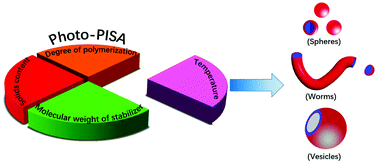An insight into aqueous photoinitiated polymerization-induced self-assembly (photo-PISA) for the preparation of diblock copolymer nano-objects†
Abstract
A poly(glycerol monomethacrylate) (PGMA) chain transfer agent is used for aqueous reversible addition–fragmentation chain transfer (RAFT) dispersion polymerization of 2-hydroxypropyl methacrylate (HPMA) via photoinitiation or thermal initiation. Kinetic studies showed that the rate of polymerization of photo-PISA was much faster than that of thermally initiated PISA, both at the homogeneous polymerization stage and the heterogeneous polymerization stage. The effect of light intensity on photo-PISA was investigated, which showed that increasing light intensity led to faster polymerization behavior. In virtue of the temperature-insensitive property of the photoinitiator, the sole effect of reaction temperature on PISA was studied in detail for the first time. Transmission electron microscopy (TEM) measurements indicated that higher reaction temperature facilitated the formation of higher order morphologies. Finally, a one-pot photoinitiated polymerization was conducted in water to prepare diblock copolymer nano-objects with different morphologies (spheres, worms, and vesicles).



 Please wait while we load your content...
Please wait while we load your content...